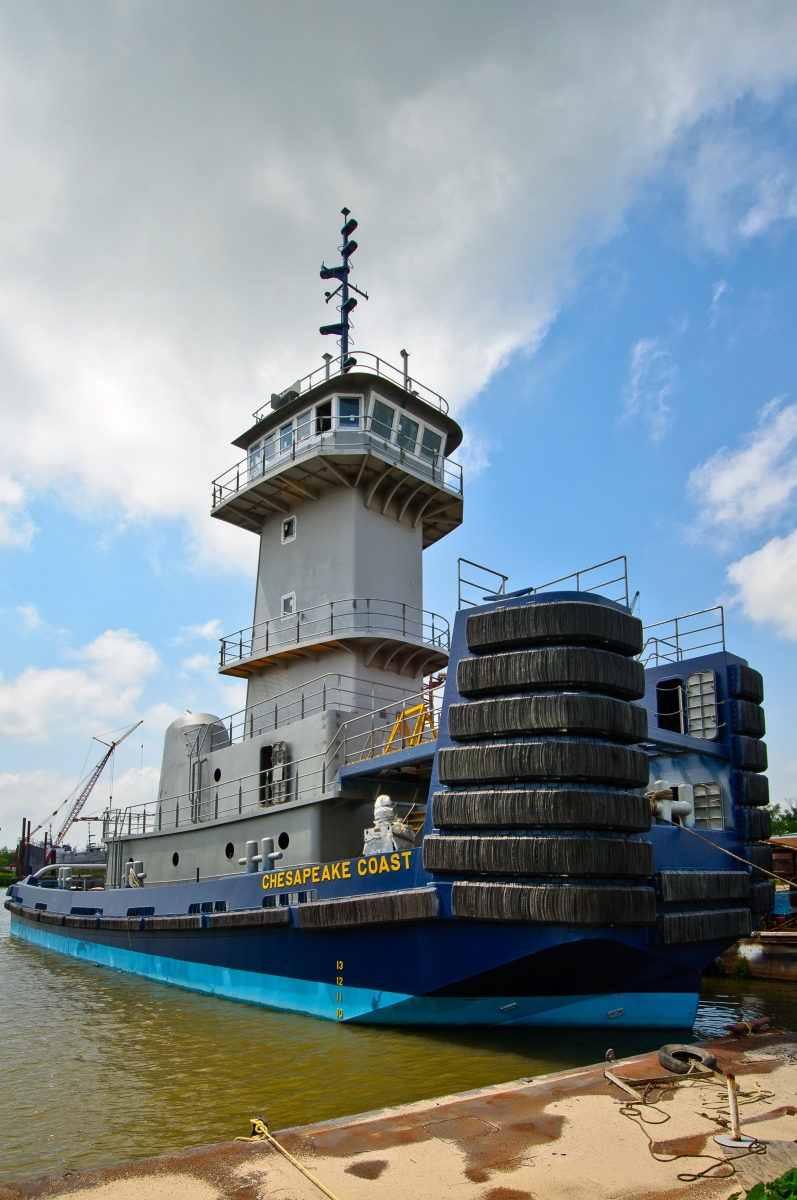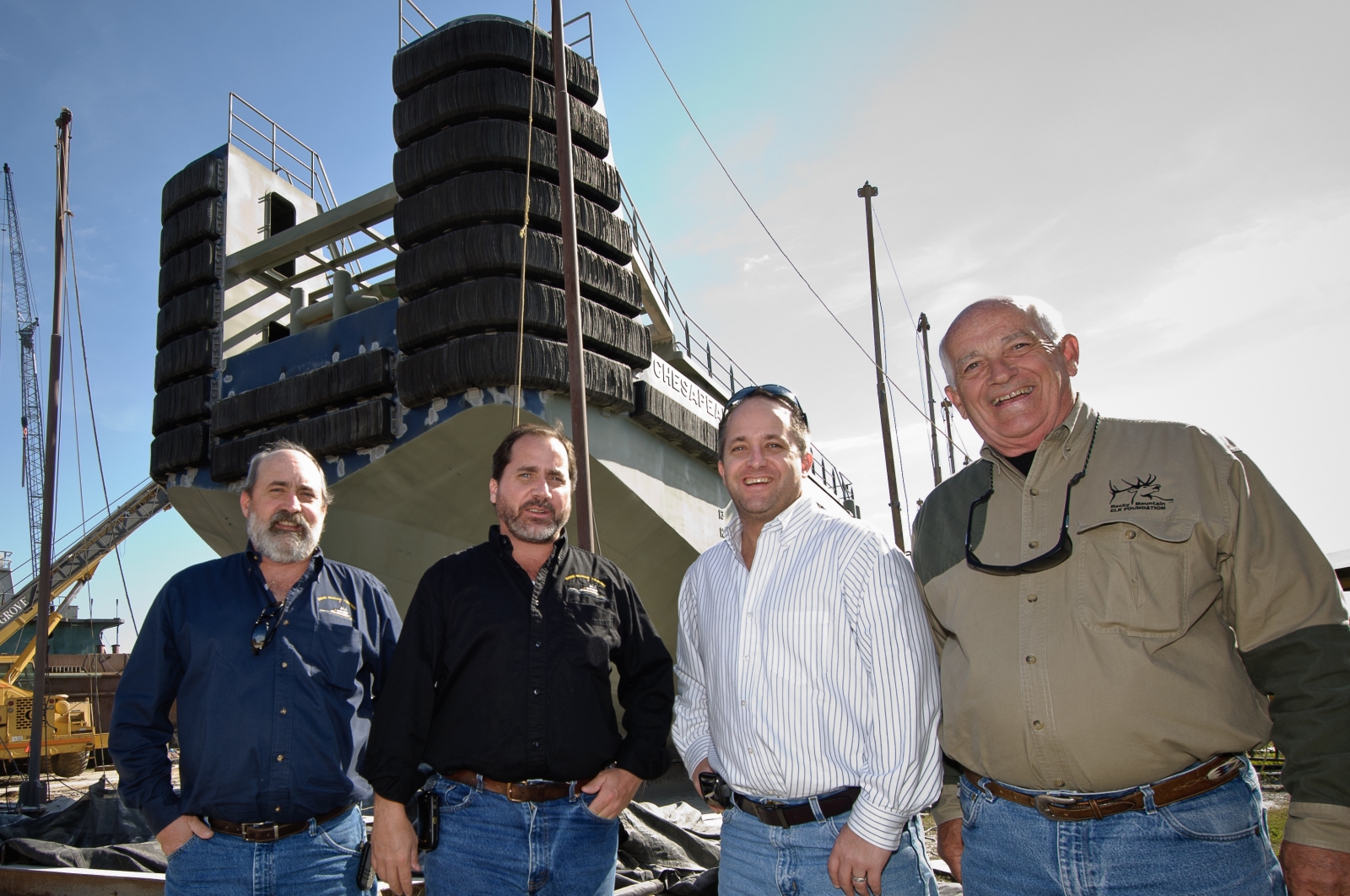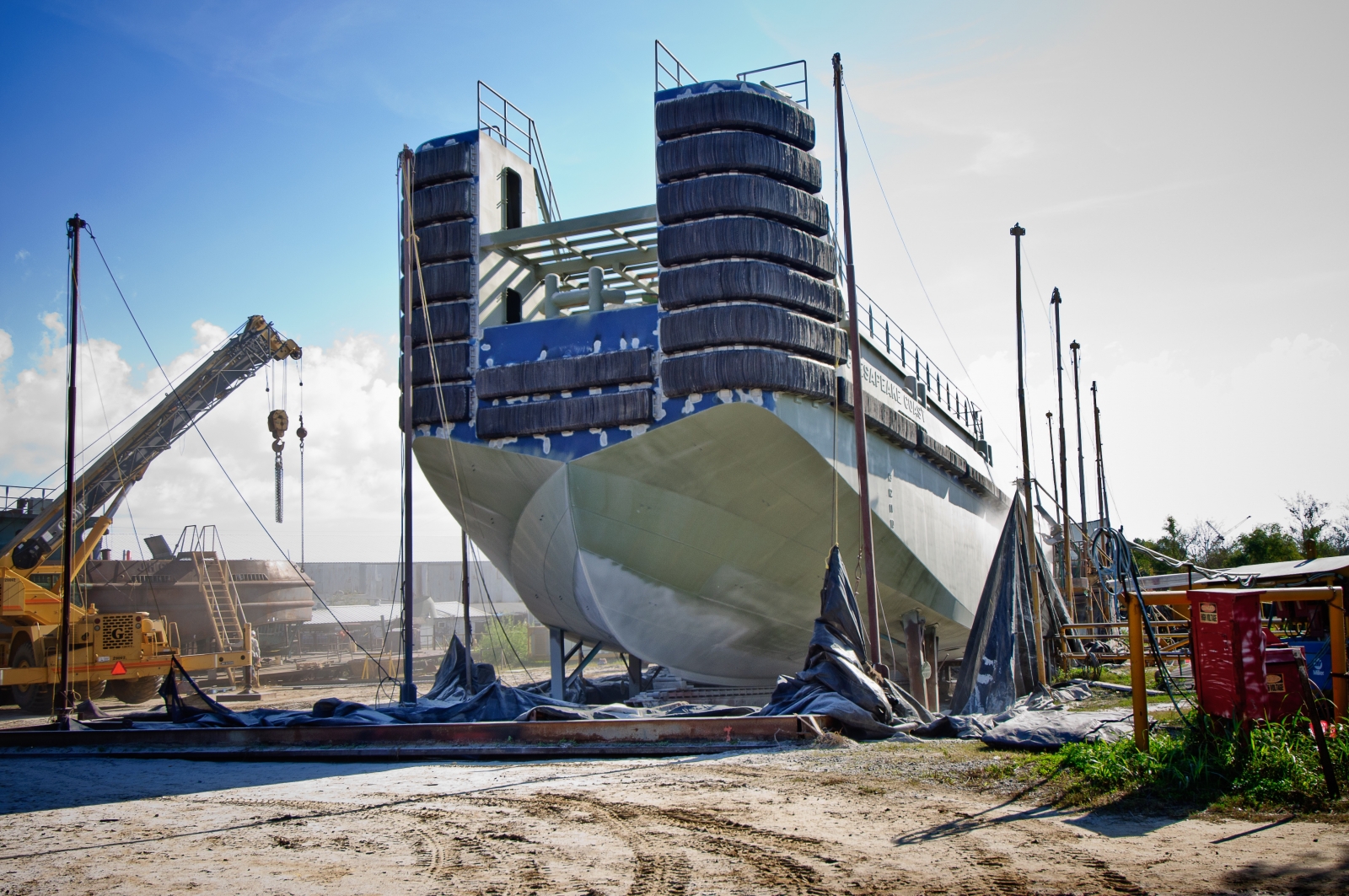Perhaps the most unusual boat this year, or in many years for that matter, is Chesapeake Coast, a Dann Marine Towing (DMT) tugboat nearing completion at Main Iron Works in Houma, La. The design is a model bow, 100-foot-long conventional tugboat, but with two massive push knees that rise 25 feet above the water, obscuring the deep-V bow.
 |
|
New tug Chesapeake Coast for Dann Marine Towing shows off massive push knees that rise to 25 feet above the water. "It's a pushboat that can tow, but we just call it a tugboat," said Robert Dann Jr. (Photo by Brian Gauvin)
|
"There have not been any knees built that big before," said Robert Dann Sr. on a recent tour of the boat with his son Robert Jr. The knees are faced with a hefty thickness of M&M Bumper rubber.
The designer, Frank Basile of Entech & Associates in Houma, calls it a combination boat, designed and equipped to push and pull barges. But other than having a towing winch on the stern, the towing aspect of the boat is not so obvious. "In the water it looks like a pushboat," said Robert Jr. who works with his father, Robert Sr., and two brothers, J.C. and Christopher, at DMT's headquarters in Chesapeake City, Md.
 |
|
Push knees are an integral part of the hull structure, which includes the deep-V bow configuration and hard chine bilges. (Photo by Brian Gauvin)
|
"But when it comes out of the water, people are going to be shocked to see the shape of that hull. It's a pushboat that can tow. It's really a model bow pushboat, but we're just going to call it a tugboat."
The design concept came from within the DMT fleet, where a couple of small tugs with push knees welded to their model bows had worked out well for the company. "We just increased it and added other features to the boat that we thought would work out in our line of business for some of our customers," said Robert Jr.
Those other features include an Intercon single-drum towing winch, model SD175, with 2,000 feet of 1.75-inch wire, and equipped with a warping head. In yet another departure from the norm, there is only one wheelhouse, with a 50-foot height of eye.
"We're going to be pushing bigger and bigger barges most of the time and that makes a lower wheelhouse redundant," said Robert Jr. "And we'll only need one set of steering controls and electronics. So, it's one wheelhouse, but it's up in the air."
|
|
|
Four members of the Dann family look like happy bosses at Main Iron Works, of Houma, La., prior to launching. They are, from left to right, Robert Dann Jr., J.C. Dann, Christopher Dann, and Robert Dann Sr. (Photo by Brian Gauvin)
|
The propulsion and equipment aboard Chesapeake Coast are much the same as the company's last two conventional tugboats, Treasure Coast and Atlantic Coast.
Chesapeake Coast is the 18th boat in the fleet, and other than Zeus, built in 1974, they are all named after specific coasts. The hull for a second boat identical to Chesapeake Coast, named Discovery Coast, is on the slipway and expected later in the year.
"We're going to be towing or pushing anything with her that we can get our hands on: cement, oil, coal, dump barges, aggregate, anything," said Dann. "We try to keep our boats and crews capable of handling all the different products out there, and we handle all of our products as if they were oil. That's the safest way."
To maintain control and higher speeds, Robert Jr. said they will push barges as much as possible, pulling them primarily when the weather deteriorates. The crew will make up the tow by running face wire through sheaves on the aft deck then forward out to the corners of the tow, the same rigging used for any tug facing up to a barge for pushing. Two 60-ton Nabrico push winches on the fore deck will be used in a typical face wire tow.
"With those wires out to the corners, we should be able to push in some pretty nasty weather," said Robert Jr. "But we have a couple of onshore/offshore dredging jobs where sometimes we'll have to put the barges on the hawser." Another interesting feature of the push knees is that they will fit into the biggest notch that one of DMTs customers has on its biggest barge. "We designed the knees so that they will take the weight of the barge on their shoulders and sides," said Robert Jr. The knees will either fit into or span all of DMT's fleet of barges as well as the barges in their customer's barge fleets.
|
|
|
Chesapeake Coast gets its propulsion power from a pair of Hung Shen propellers encased in Rice nozzles and Rice triple-vane rudders.(Photo by Brian Gauvin)
|
The engines are Caterpillar 3512-B Tier II diesels with Reintjes 6:1 reduction gears and internal shaft brakes. The propellers are provided by HS Marine Propulsion, a new company based in Pascagoula, Miss., that has distribution rights for Hung Shen propellers in North America. The propellers are in Rice nozzles with triple-vane rudders. "The triple rudder is another feature that we took off Atlantic and Treasure that will make it very maneuverable," said Robert Jr.
"The boat will be fuel-efficient when pushing because there's less drag on the boat, and there will be more comfort in the ride for the crew because you're going to be cutting through the water instead of pounding into it," he said.
The upper wheelhouse is being fitted out with the signature Spanish cedar that Main Iron Works has become famous for. The South American wood is also used as trim throughout the tug. The console in the wheelhouse is positioned so that the helmsman can move in front of it, right up to the forward windows, a much safer configuration giving the helmsman a clear and straight line of sight to the foredeck of the tug and farther ahead over the barge.
The late LeRoy Molaison of Main Iron Works commented last fall, when Chesapeake Coast was still on the slipway, that the push/tow combination design was the first one like it he had encountered. "But they will work a lot better offshore with that V-hull and the push knees," said Molaison. "The barges won't stray from side to side (as they might with a tow made up on a model bow), and if it gets really rough they can just put them on the string. These are the first of a kind for us."
Dann Marine Towing is located in the historic Canal Place complex of buildings on the north bank of the Chesapeake & Delaware Canal, in Chesapeake City, Md. The company has a five-generation history in the towing business, stretching back to the 1870s in Florida.
Robert Sr. had his first new build tug, Ocean Tower, built at Main Iron Works in 1968. Capt. Robert as he was known, along with his wife Joan, later formed the Robert Dann Company, which was later changed to Dann Marine Towing.
DMT's fleet, ranging in horsepower from 1,100 to 4,200, operates on the U.S. East Coast, Gulf of Mexico, Caribbean, and South America, as well as on the Great Lakes. The company also has a fleet of jumbo hopper barges, deck barges and two self-unloading cement barges.
When Chesapeake Coast joins the DMT fleet, the push/tow combination tugboat will be fully-classed with ABS for ocean service. "It's not a requirement," said Robert Jr., "but we're just doing it. We did it on the last two boats, so we're going to do it on these two. It just holds your boat to a higher standard and hopefully keeps us ahead of the curve when new rules come out."




